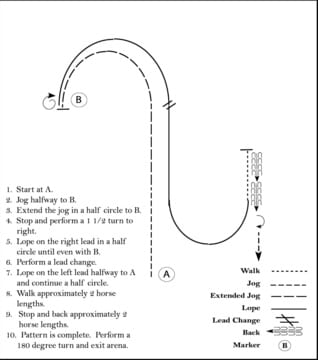With 13 World Championships and 10 Reserve World Championships in eight different events, we are pleased that AQHA judge and trainer Nancy Alto-Renfro has agreed to break down a Congress Horsemanship pattern for GoHorseShow. Renfro who is World and Congress Champion in this event has also trained the recent back-to-back AQHA Select World Champion in the horsemanship, Christine Hocutt-Senteney.
- When I first take a look at this pattern, I am looking for cone placement and general layout of the pattern. I take note that two cones will be used and the pattern has straight lines and half circles. The pattern starts at cone A in the center of the arena. I advise my clients to start two steps back from cone A so that they have a step or two to move into a nice crisp two beat jog.
- Consistent pace is very important. You want to move up to a true strong two beat jog and maintain that pace to the next maneuver. Too often you see runs that are very inconsistent in their pace either starting out too slow then quickening their pace or too fast and then slowing the pace down. I stress this to my clients, “Keep your pace the same.” This is the judges’ first impression of you and your chance to make them take notice of you.
 The pattern calls for a transition to the extended trot half way between cone A and cone B. Go watch the pattern being set up or several goes to determine where the center point is between cone A and cone B. Make a mental note of a spot on the arena wall that is the middle this way you will know to jog to that spot before executing your extended trot. I use a lot of visual arena aides at the shows. It helps exhibitors know where they are in the arena and performing the maneuvers at the correct spot.
The pattern calls for a transition to the extended trot half way between cone A and cone B. Go watch the pattern being set up or several goes to determine where the center point is between cone A and cone B. Make a mental note of a spot on the arena wall that is the middle this way you will know to jog to that spot before executing your extended trot. I use a lot of visual arena aides at the shows. It helps exhibitors know where they are in the arena and performing the maneuvers at the correct spot.
- Once you have jogged straight half way to cone B you will move into an extended trot. Having a strong two beat jog will make this transition easier. Build to your pace. Often we see riders cue too strongly and lope off. Let this transition build within the first two to four steps then maintain the extended trot pace in a straight line passing cone B, you will probably go at least four strides past cone B before starting your left half circle.
- Maintain your pace. Don’t keep building your trot at this time. You want to finish your half circle and be completely straight when performing your next maneuver the stop. I would tell my client to stop with cone B at the horses shoulder or at your leg. When you stop make sure you settle a second so your horse’s motion has stopped before starting your turn. This will help your turn start correctly and shows the judges you have complete control of your horse. Start your 1 1/2 turn to the right softly building it as you go. This way your horse understands that he is turning around and not stepping forward or backwards out of the turn.
- Next you lope back off on the right lead. I like to see my riders complete the turn and then step off into the lope efficiently. Make sure your turn is complete and your horse is in the correct position to lope off. Slight hesitation is okay if you have a nice crisp lope departure. Judges want to see that you have control of your horse. Remember faster is not always better.
- Lope forward and then complete your half circle. The pattern is drawn so that the Right lead lope circle is slightly large than the extended trot circle. Keep you lope stepped up since you will be performing an lead change. If your pace is too slow you will have a rough lead change. Your lead change takes place directly across from Cone B and directly coming towards cone A. Prepare in advance for the change. Know where you are in your circle. Be looking ahead to move your horse into position that is straight a stride or two before cone B. Cone A is guide at this point to help you be in the correct line in your pattern.
- Ask for the change at cone B. It doesn’t state a flying or simple lead change. If your horse has a flying change do it. If your horse doesn’t have or the flying change is rough it is better to perform an nice pretty simple lead change than a bad flying lead change. After the change, keep your pace the same.
- You will continue straight towards cone A on the left lead and lope a half circle to the left. This maneuver sets up your transitions to the walk. Be sure you are straight and ride strong to your walk transition. Too often we see riders weaken because they know they are slowing to the walk and their horse breaks to the jog or stops before walking.
- The transition to the walk begins slightly before the center of cone A and cone B. Again look at spots on the arena walls to find a visual aid to know where to break down to the walk. You want to break down from the lope to a nice forward moving walk, without jogging or stopping the motion. Practicing this maneuver is a must. Rider and horse must be in sync and have their timing down. The pattern calls for walking approximately two horse lengths. I would advise walking 6 to 8 steps. This way you are showing the judges you are in control of the walk.
- Then, you stop and back approximately six to eight steps. The pattern says it is complete but then asks for you to perform a 180 degree turn and exit. It does not say to exit at a walk or jog. I believe it is to help keep the class moving. I would turn which ever way your horse turns best and exit at a trot. It shows confidence and courtesy to the judges.
- This pattern has a lot of forward maneuvers early in the pattern. It slows down at the end. Remember to keep things under control and don’t override towards the end of your pattern. Sometimes riders stiffen towards the end of their pattern knowing they are almost done. Stay riding strong but relax your hand and feet so you don’t cue too strongly for the walk transition. You don’t want to pull too hard or accidentally spur too hard at that point. Good Luck!






